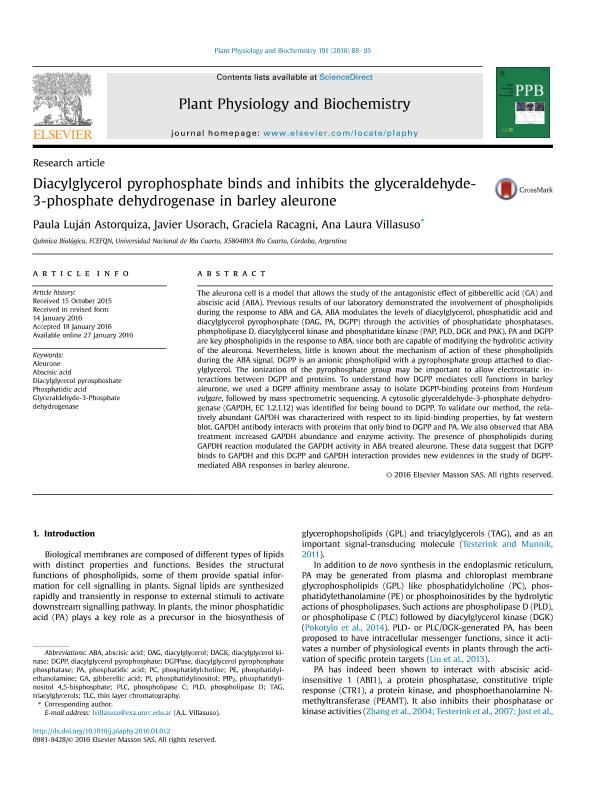Artículo
Diacylglycerol pyrophosphate binds and inhibits the glyceraldehyde-3-phosphate dehydrogenase in barley aleurone
Fecha de publicación:
01/2016
Editorial:
Elsevier France-Editions Scientifiques Medicales Elsevier
Revista:
Plant Physiology and Biochemistry
ISSN:
0981-9428
Idioma:
Inglés
Tipo de recurso:
Artículo publicado
Clasificación temática:
Resumen
The aleurona cell is a model that allows the study of the antagonistic effect of gibberellic acid (GA) and abscisic acid (ABA). Previous results of our laboratory demonstrated the involvement of phospholipids during the response to ABA and GA. ABA modulates the levels of diacylglycerol, phosphatidic acid and diacylglycerol pyrophosphate (DAG, PA, DGPP) through the activities of phosphatidate phosphatases, phospholipase D, diacylglycerol kinase and phosphatidate kinase (PAP, PLD, DGK and PAK). PA and DGPP are key phospholipids in the response to ABA, since both are capable of modifying the hydrolitic activity of the aleurona. Nevertheless, little is known about the mechanism of action of these phospholipids during the ABA signal. DGPP is an anionic phospholipid with a pyrophosphate group attached to diacylglycerol. The ionization of the pyrophosphate group may be important to allow electrostatic interactions between DGPP and proteins. To understand how DGPP mediates cell functions in barley aleurone, we used a DGPP affinity membrane assay to isolate DGPP-binding proteins from Hordeum vulgare, followed by mass spectrometric sequencing. A cytosolic glyceraldehyde-3-phosphate dehydrogenase (GAPDH, EC 1.2.1.12) was identified for being bound to DGPP. To validate our method, the relatively abundant GAPDH was characterized with respect to its lipid-binding properties, by fat western blot. GAPDH antibody interacts with proteins that only bind to DGPP and PA. We also observed that ABA treatment increased GAPDH abundance and enzyme activity. The presence of phospholipids during GAPDH reaction modulated the GAPDH activity in ABA treated aleurone. These data suggest that DGPP binds to GAPDH and this DGPP and GAPDH interaction provides new evidences in the study of DGPP-mediated ABA responses in barley aleurone.
Archivos asociados
Licencia
Identificadores
Colecciones
Articulos(CCT - CORDOBA)
Articulos de CTRO.CIENTIFICO TECNOL.CONICET - CORDOBA
Articulos de CTRO.CIENTIFICO TECNOL.CONICET - CORDOBA
Citación
Astorquiza, Paula Luján; Usorach, Javier Iván; Racagni, Graciela Esther; Villasuso, Ana Laura; Diacylglycerol pyrophosphate binds and inhibits the glyceraldehyde-3-phosphate dehydrogenase in barley aleurone; Elsevier France-Editions Scientifiques Medicales Elsevier; Plant Physiology and Biochemistry; 101; 1-2016; 88-95
Compartir
Altmétricas




